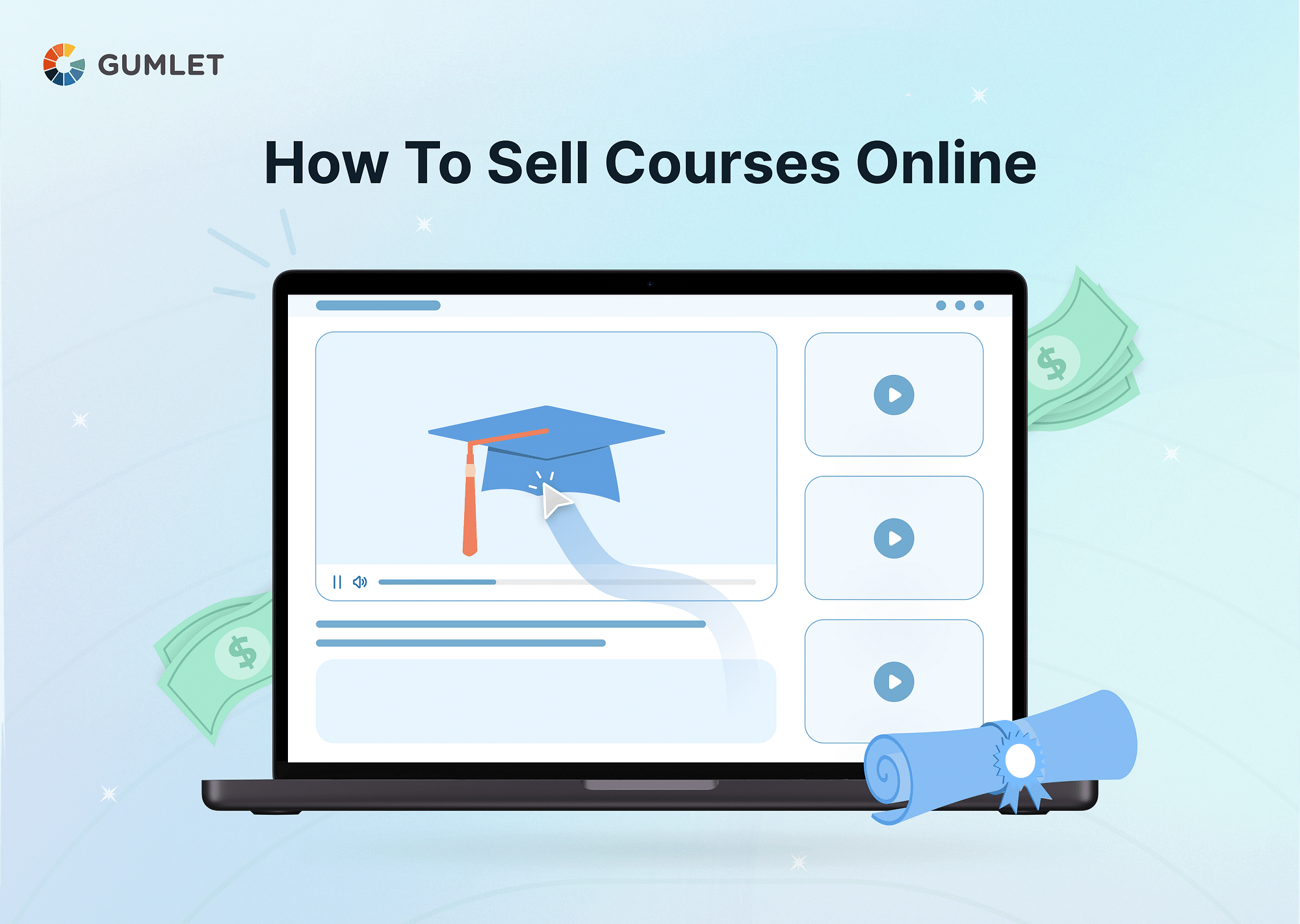Introduction
In the digital age, the world of education has undergone a significant transformation. Online courses have become a formidable force, offering individuals the opportunity to learn, earn, and share their knowledge with a global audience. The flexibility, income potential, and impact on learners have made selling online courses a lucrative venture. In this article, we will guide you through the intricate process of how to sell courses online successfully.
Why Building a High-Quality Online Course is the First Step?
Before you embark on the journey of how to sell courses online, there's a critical initial step that should not be overlooked: the creation of high-quality course content. This step is the bedrock upon which your entire course sales strategy stands. Here's why it's paramount:
- First Impression Matters: The quality of your course content is the first thing potential students will notice. High-quality content creates a positive first impression and sets the stage for a successful learning experience.
- Enhanced Engagement: Visually appealing graphics, slides, and screen recordings make your course more engaging and effective. Visual aids help learners grasp complex concepts more easily, increasing their satisfaction with your course.
- Consistent Branding: Maintaining consistent branding throughout your course materials reinforces your professionalism and helps students recognize your courses instantly. This branding consistency builds trust and credibility.
To take your course quality to the next level, consider Gumlet's Player Customization features. It allows you to tailor the course video player to match your branding, creating a seamless and visually pleasing learning experience for your students.
Creating high-quality course content is not just about visual appeal; it's about providing value to students and ensuring an exceptional learning experience, which significantly boosts the success of your courses.
Choose the Right Online Course Distribution Channel
This section discusses the importance of choosing the right online course distribution channel, including your website, popular online course platforms, or learning management systems (LMS). Understanding the pros and cons of each option is crucial for making an informed choice for your course-selling journey.
Selling courses on your own website
Selling courses directly on your own website offers several advantages for creators, but it comes with its set of responsibilities and challenges.
Advantages:
- Complete Control: You have full control over your course content, pricing, and branding. This enables you to create a unique and tailored learning experience for your students.
- Higher Profit Margins: By avoiding platform fees, you can potentially earn more from each course sale.
- Branding: Your website becomes a brand hub, reinforcing your identity as an educator or expert.
Challenges:
- Technical Setup: Setting up a user-friendly and secure e-commerce system on your website can be technically challenging, requiring web development skills or external help.
- Marketing: Without the built-in audience of a platform, you'll need to invest more in marketing efforts to drive traffic to your site.
- Payment Processing: Handling payment processing and ensuring secure transactions can be complex and may require integration with payment gateways.
Meet Gumlet: To enhance your course delivery on your website, consider Gumlet. It offers complete control over your course videos, ensuring buffer-free streaming, 4K video support, detailed analytics, player customization, and critical video protection features like DRM. These features not only elevate the learning experience but also protect your valuable content from piracy.
Selling courses on an Online Course Platform
Online course platforms like Udemy, Teachable, Kajabi, and Podia are popular choices for creators. Here's what you need to know about this distribution channel:
Advantages:
- Ready-Made Audience: These platforms have an existing user base, giving your courses immediate exposure.
- Marketing Support: They often provide marketing tools and resources to help you promote your courses effectively.
- Simplified Setup: You can get started quickly without the technical hassles of building your website.
Challenges:
- Platform Fees: Most platforms charge a fee for hosting your courses, which can affect your overall earnings.
- Limited Control: You may have restrictions on pricing, branding, and communication with your students.
- Competition: These platforms host numerous courses, making it crucial to stand out and market effectively.
Recommendation: Udemy is great for a vast audience, Teachable offers customization, Kajabi focuses on marketing tools(you can check out this guide to Kajabi Free Trial), and Podia is user-friendly. Carefully evaluate their features, pricing, and your target audience to determine the best fit.
Selling Courses on a Learning Management System (LMS)
A Learning Management System (LMS) is ideal for institutions and businesses delivering structured training and education.
Advantages:
- Scalability: LMS platforms can handle large volumes of students and courses, making them suitable for organizations.
- Structured Learning: LMS systems offer a structured approach to course delivery, often with assessment tools and reporting features.
- Control and Security: You have control over user access, data security, and compliance.
Challenges:
- Complex Setup: Implementing an LMS can be complex and may require dedicated IT resources.
- Cost: Licensing and maintaining an LMS can be expensive, especially for smaller businesses or individual creators.
- Limited Marketing Support: LMS platforms typically focus on course delivery and administration rather than marketing.
LMS is best suited for institutions and businesses that require robust training solutions but may not be the ideal choice for individual course creators unless they are targeting a corporate or organizational audience.
Setting the Right Pricing Strategy for Your Courses
Pricing your online courses strategically is a pivotal aspect of your overall success as an online course creator. Here, we'll delve into the key elements of a sound pricing strategy, ensuring that you maximize your revenue while providing value to your students.
- Competitor Analysis & Course Value: Examine the prices and offerings of similar courses in your niche. Identify where your course stands out, focusing on unique content or superior learning experiences.
- Tiered Pricing & Bundles: Offer multiple pricing levels to suit different budgets and needs. Consider bundling courses for a discount, encouraging students to purchase more.
- Promotions: Utilize introductory discounts and payment plans to attract early learners and make courses more accessible.
- Pricing Models: Choose a model that reflects your course's value. Options include value-based pricing for premium content, a subscription model for ongoing access, or a freemium model with basic content for free and premium features at a cost.
Remember to regularly review and adjust your pricing in line with market trends and feedback. This ensures profitability while showcasing the value of your courses.
How to Market Your Online Course?
Effectively marketing your online course is the linchpin of your success as a course creator. Here, we'll break down the key marketing strategies and tactics tailored to different distribution channels: your own website, online course platforms, and Learning Management Systems (LMS).
Building Your Audience
Building a dedicated audience is the cornerstone of successfully selling your online course. Whether you're hosting your course on your own website, utilizing online course marketplaces, or an LMS, these strategies will help you create a loyal and engaged community of learners.
On Self-Hosted Website:
- On your own website, dedicate a page exclusively to your course. Craft a compelling course description that highlights the benefits and outcomes students can expect.
- Include persuasive testimonials from previous students who have benefited from your course. Real-life success stories add credibility and trust.
- Place clear and prominent calls to action (CTAs) throughout the video landing page, guiding visitors to enroll in your course.
- Promote your course on social media platforms like Facebook, Twitter, Instagram, and LinkedIn by creating engaging posts, using relevant hashtags, and joining relevant communities to reach your target audience.
- Create an email list of potential customers and provide them with engaging content related to your course topic, along with personalized invitations to the course. One creative way to collect emails is to use a quiz that helps users choose the best course for their needs. Before users can view the results, they're asked to input their email. This approach works on all popular website builders. You can create a WordPress, Wix, or Squarespace quiz and embed it on your website.
- Run pre-launch campaigns to generate buzz for your course, sharing teasers, sneak peeks, and behind-the-scenes content and offering exclusive incentives like discounts or bonuses to early enrollees.
On Online Course Marketplaces:
- Use the marketplace's course listing to create an enticing description that speaks to your course's unique value proposition.
- Incorporate customer reviews and ratings in online courses to showcase the effectiveness and credibility of your course.
- Ensure your course title, subtitle, and course image are attention-grabbing and align with your target audience's interests.
- Share your course listing on your personal and professional social media profiles to tap into your existing network.
- Collaborate with the marketplace's promotional features, such as sponsored posts or email newsletters, to reach a broader audience.
- If the marketplace allows, send targeted email campaigns to users who have shown interest in similar courses. Craft compelling messages that encourage enrollment.
- Utilize the marketplace's promotional tools to create pre-launch excitement. Tease the course's content and encourage users to wishlist or enroll when it becomes available.
On LMS:
- Customize your course's landing page within the LMS to reflect your course's benefits, prerequisites, and objectives.
- Encourage engagement by offering interactive elements like quizzes or sample content.
- Include clear instructions on how to enroll within the LMS environment.
- Engage with the LMS's internal social features, such as forums or discussion boards, to promote your course and answer questions.
- Encourage enrolled students to share their progress or insights on their own social media, expanding your course's reach through user-generated content.
- Use the LMS's internal email features to communicate with enrolled students. Share additional resources, updates, or bonus content to keep them engaged throughout the course.
- Within the LMS, schedule pre-launch events or webinars to showcase the value of your course and provide a taste of what students can expect.
- Offer early access or discounts to generate initial interest and enrollments.
By implementing these strategies, you can effectively build and engage with your audience, driving more enrollments and ensuring the success of your online course, regardless of the distribution channel you choose.
Leverage Content Marketing
Content marketing is a powerful strategy for attracting and engaging potential students across different distribution channels, including your own website, online course marketplaces, and Learning Management Systems (LMS). Here's how to sell courses online using content marketing to boost your course sales:
- On a Self-hosted website
- Share Valuable Insights on Your Blog: Maintain a high-quality blog on your course topic, regularly publishing articles that provide in-depth insights and practical advice to establish yourself as an authority in your field.
- Offer Free Sessions and Resources:
- Host free webinars or workshops related to your course content. These sessions provide potential students with a taste of your expertise and the value they can expect from your full course.
- Create downloadable resources such as ebooks, guides, or templates that provide actionable takeaways.
- Guest Post on Relevant Websites:
- Collaborate with industry-specific websites or blogs to publish guest posts. Share your knowledge and insights, ensuring that your byline includes a link to your course or website.
- Guest posting not only extends your reach but also establishes your credibility within your niche.
- On Online Course Marketplaces
- Optimize Your Course Listing:
- Use the marketplace's course description and supplementary content sections to provide valuable insights and tips related to your course topic.
- Highlight your expertise and unique teaching approach in your course description to attract potential students.
- Offer Free Preview Content:
- Take advantage of the platform's preview features to offer sample lessons, videos, or course materials that showcase your teaching style and course content.
- Allow potential students to get a glimpse of what they will learn by enrolling in your course.
- Participate in Marketplace Communities:
- Engage with the platform's community features, such as forums or discussion boards, to answer questions, provide valuable insights, and build a positive reputation.
- Share your knowledge and encourage discussions related to your course topic.
- Optimize Your Course Listing:
- Learning Management System (LMS)
- Customize Content for LMS Environment:
- Within the LMS, create and curate educational content that complements your course. Offer supplementary resources, articles, or videos that enhance the learning experience.
- Share relevant news or updates that keep your students informed and engaged.
- Host Webinars or Live Sessions:
- Use the LMS's built-in features for hosting webinars or live Q&A sessions. These events can provide additional value to your enrolled students and attract new ones.
- Promote these sessions to your audience to encourage course enrollment.
- Collaborate with LMS Communities: Utilize the LMS's community features to encourage student interaction and discussions, enhancing engagement and bolstering your reputation as a trusted instructor.
- Customize Content for LMS Environment:
Incorporating content marketing into your course-selling strategy not only helps you reach a wider audience but also positions you as an authority in your field. By sharing valuable insights, offering free sessions, and collaborating with relevant platforms, you can effectively attract and engage potential students across different distribution channels, ultimately driving course enrollments and success.
Promoting Your Course: Leveraging Paid & Promotional Advertising
Promotional advertising is a vital component of your course marketing strategy. It enables you to reach a broader audience, remind potential students of your course's value, and create brand awareness. Whether you are hosting your course on your own website, online course marketplaces, or an LMS, here's how to sell courses online using paid advertising and promotional efforts:
- On Self-Hosted Website:
- Run Targeted Ads on Social Media and Search Engines:
- Utilize platforms like Facebook Ads and Google Ads to reach your ideal student demographic with precision. These platforms offer robust targeting options, allowing you to tailor your ads to specific age groups, interests, and locations.
- Create compelling ad copy and visuals that resonate with your target audience, highlighting the benefits and unique selling points of your course.
- Implement Retargeting Ads:
- Retargeting is a powerful technique to re-engage website visitors who showed initial interest but didn't enroll in your course. Display retargeting ads across the web to remind them about your course.
- Use compelling visuals and persuasive messaging in retargeting ads to encourage potential students to take action and enroll.
- Partner with Influencers, Blogs, and Online Communities: Boost course visibility by partnering with niche influencers for endorsements, guest posting on relevant blogs, and engaging with online communities to share expertise and subtly promote your course.
- Offer Free Webinars or Sneak Peeks: Use free webinars or course previews to demonstrate your expertise and course value, promoting them via email, social media, and your website to encourage full course enrollment.
- Run Targeted Ads on Social Media and Search Engines:
- On Online Course Marketplaces
- Utilize Platform Advertising Options:
- Boost your course's visibility on online marketplaces by investing in sponsored listings or promotions, and optimize your course title, description, and images for maximum appeal.
- Leverage Retargeting: Implement retargeting campaigns for potential students who viewed your course listing but didn't enroll. Remind them about the value of your course through retargeting ads both on and off the platform.
- Collaborate with Influential Instructors: Partner with influential instructors or top-rated course creators within the marketplace to cross-promote each other's courses. This mutually beneficial arrangement can expose your course to a larger audience.
- Utilize Platform Advertising Options:
- On Learning Management System (LMS)
- Promote Within the LMS Community:
- Actively engage with the LMS's internal community, participating in discussions, forums, and events. Subtly promote your course within the community to attract enrolled students.
- Showcase the value of your course by sharing success stories and testimonials from past students.
- Host Webinars and Live Q&A Sessions: Use the LMS's built-in features to host webinars, live Q&A sessions, or exclusive course previews for enrolled students. These events foster engagement and encourage enrollment in your course.
- Collaborate with LMS Administrators: Establish a relationship with LMS administrators or decision-makers to gain support for promoting your course within the platform. They may assist in featuring your course or providing additional visibility.
- Promote Within the LMS Community:
By utilizing targeted ads, retargeting campaigns, influencer partnerships, and offering free previews, you can effectively promote your course and increase enrollment, ultimately contributing to your course's success.
Protecting Your Video Courses from Piracy
Protecting your video courses from piracy is of paramount importance for any online course creator. When your content is pirated, it becomes freely available to anyone, undermining your ability to sell your courses and generate revenue. Thankfully, there are effective methods to counter piracy, and Gumlet provides essential features to bolster the security of your video courses.
The Significance of Anti-Piracy Measures
Implementing anti-piracy measures is crucial for several reasons:
- Revenue Protection: Piracy can significantly impact your income potential. When your courses are readily available for free on unauthorized platforms, potential students have little incentive to purchase them.
- Preserving Course Value: Pirated copies may lack the quality, interactivity, and support that your official courses provide. This can result in a poor learning experience, damaging your reputation and brand.
- Ensuring Fair Compensation: As a course creator, you invest time, expertise, and resources in developing your content. Anti-piracy measures ensure you receive fair compensation for your hard work.
Best Video Protection Methods
Gumlet offers robust video protection features that can be easily enabled to safeguard your video courses:
- Video DRM (Digital Rights Management):
- DRM technology encrypts your video content, making it difficult for unauthorized users to access, download, or distribute your courses.
- It grants you control over who can view your content and for how long, helping protect your intellectual property.
- Dynamic Watermarking:
- Dynamic watermarking allows you to overlay your videos with unobtrusive but identifiable markings.
- Watermarks deter users from sharing or redistributing your content, as it can be traced back to the source.
- Password Protected Videos:
- By password-protecting your videos, you ensure that only authorized users with the correct password can access your course content.
- This adds an extra layer of security, preventing unauthorized viewers from gaining access.
How to Scale Your Online Teaching Business?
To expand your online teaching business, consider these strategies:
- Develop New Courses: Create additional courses to cater to a wider audience.
- Partnerships: Partner with other educators or course creators to offer bundled learning experiences.
- Data Analysis: Continuously track and analyze data to optimize your marketing and sales strategies.
Build an Active Online Community
Creating an online community for courses improves learning experiences, fosters student loyalty, enhances understanding through peer interactions, and serves as a powerful marketing tool. Satisfied students are more likely to recommend your courses, simplifying future marketing efforts and providing valuable feedback. To foster a loyal student community, establish forums, host Q&A sessions, and reward active members. This approach leads to a more connected student base, simplifying marketing efforts and providing valuable feedback, thereby enhancing course improvement and promotion.
Delivering Excellent Customer/Student Support
Online teaching requires exceptional customer support, including prompt responses to student inquiries, technical guidance, and self-help resources. Regular surveys and support ticket systems can help manage queries. Personalized assistance for individual student challenges enhances the learning experience and course improvement.
Delivering excellent customer support enhances the learning experience, builds trust, and promotes loyalty among students. This commitment fosters a positive reputation, encourages word-of-mouth recommendations, and positions the educator as a trusted educator. Collecting student feedback ensures course relevance and effectiveness.
Key Takeaways
Selling your online courses successfully requires a multifaceted approach that encompasses course quality, video distribution channels, pricing strategies, marketing efforts, and measures to safeguard your content. Here are the key takeaways from this comprehensive guide:
- Course Quality is Paramount
- Choose the Right Distribution Channel
- Set the Right Pricing Strategy
- Effective Course Marketing is Essential
- Safeguard Your Content Against Piracy
- Scale Your Online Teaching Business
- Build an Active Online Community
- Deliver Excellent Customer/Student Support
By following these key principles and strategies, you can navigate the evolving landscape of online course sales and build a successful and sustainable online teaching business.




